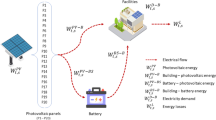Abstract
We consider a supply function model of a poolco electricity market where demand varies significantly over a time horizon such as a day and also has a small responsiveness to price. Although there are equilibria yielding prices at peak that are close to Cournot prices, it is known that the wider the range of demand uncertainty the narrower the range of such supply function equilibria. Here we show that such equilibria are also typically unstable and consequently would be difficult to sustain in practice. This strengthens the results of Green and Newbery by ruling out many equilibria that have high prices. We demonstrate this result both theoretically under somewhat restrictive assumptions and also numerically using both a three-firm example system and a five-firm example system having generation capacity constraints. Hence, this reinforces the conclusion that the market outcome is significantly influenced by a requirement that offers into the poolco be consistent over the time horizon. This result contrasts with markets where bids can be changed on an hourly basis, where Cournot prices are possible outcomes. The stability analysis has important policy implications for the design of day-ahead electricity markets. The stability perspective also provides a narrowing of the equilibrium selection that strengthens empirical analysis.
Similar content being viewed by others
References
F. Alvarado (1999) ArticleTitleThe stability of power system markets IEEE Transactions on Power Systems 14 IssueID2 505–511 Occurrence Handle10.1109/59.761873
F. L. Alvarado J. Meng C. L. DeMarco W. S. Mota (2001) ArticleTitleStability analysis of interconnected power systems coupled with market dynamics IEEE Transactions on Power Systems 16 IssueID4 695–701 Occurrence Handle10.1109/59.962415
Baldick, R., & Hogan, W. (2002a). Capacity constrained supply function equilibrium models of electricity markets: Stability, non-decreasing constraints, and function space iterations. University of Energy Institute POWER Paper PWP-089, www.ucei.berkeley.edu/ucei/PDF/pwp089.pdf.
Baldick, R., & Hogan, W. (2002b). Stability of supply function equilibria: Implications for daily versus hourly bids in a poolco market. In Proceedings of the Seventh Annual POWER Research Conference (pp. 3.1–3.19), Berkeley, California: University of California Energy Institute.
Baldick, R., & Hogan, W. (2004) Polynomial approximations and supply function equilibrium stability. In 6th IAEE European Conference, Modeling in Energy Economics and Policy, Zurich, Switzerland,September 2004. Swiss Association for Energy Economics, Centre for Energy Policy and Economics.
Baldick, R., Grant, R., & Kahn, E. P. (2000). Linear supply function equilibrium: Generalizations, application, and limitations. University of California Energy Institute POWER Paper PWP-078, www.ucei.berkeley.edu/ucei/PDF/pwp078.html.
R. Baldick R. Grant E. Kahn (2004) ArticleTitleTheory and application of linear supply function equilibrium in electricity markets Journal of Regulatory Economics 25 IssueID2 143–167 Occurrence Handle10.1023/B:REGE.0000012287.80449.97
A.R. Bergen V. Vittal (2000) Power systems analysis EditionNumber2 Prentice-Hall, Upper Saddle River NJ
H. Chen K.P. Wong D.H.M. Nguyen C.Y. Chung (2006) ArticleTitleAnalyzing oligopolistic electricity market using coevolutionary computation IEEE Transactions on Power Systems 21 IssueID1 143–152 Occurrence Handle10.1109/TPWRS.2005.862005
C.J. Day D.W. Bunn (2001) ArticleTitleDivestiture of generation assets in the electricity pool of England and Wales: a computational approach to analyzing market power Journal of Regulatory Economics 19 IssueID2 123–141 Occurrence Handle10.1023/A:1011141105371
Genc, T., & Reynolds, S.S. (2005). Supply function equilibria with pivotal suppliers. http://www.u.arizona.edu/~sreynold/sfe2.pdf.
R. Green (1996) ArticleTitleIncreasing competition in the British electricity spot market The Journal of Industrial Economics XLIV IssueID2 205–216 Occurrence Handle10.2307/2950646
R. Green D.M. Newbery (1992) ArticleTitleCompetition in the British electricity spot market Journal of Political Economy 100 IssueID5 929–953 Occurrence Handle10.1086/261846
P.D. Klemperer M.A. Meyer (1989) ArticleTitleSupply function equilibria in oligopoly under uncertainty Econometrica 57 IssueID6 1243–1277 Occurrence Handle10.2307/1913707
M. Nerlove (1958) Adaptive expectations and cobweb phenomena.Quarterly Journal of Economics 73 IssueID2 227–240
Rudkevich, A. (1999). Supply function equilibrium in poolco type power markets: learning all the way. Technical Report TCA Technical Paper Number 1299-1702, Tabors Caramanis and Associates.
J. Tirole (1988) The theory of industrial organization The MIT Press Cambridge, MA, London, England
Author information
Authors and Affiliations
Corresponding author
Rights and permissions
About this article
Cite this article
Baldick, R., Hogan, W.W. Stability of supply function equilibria implications for daily versus hourly bids in a poolco market. J Regul Econ 30, 119–139 (2006). https://doi.org/10.1007/s11149-006-0017-2
Issue Date:
DOI: https://doi.org/10.1007/s11149-006-0017-2




